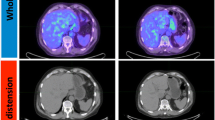Abstract
The purpose of the study was to compare the quality of stomach and small bowel marking/labeling using 1,350 ml of low-density barium alone (VoLumen) with 900 ml of low-density barium and 450 ml of water for 16-MDCT scans of the abdomen and pelvis and assess cost benefits with the two protocols. In this IRB approved study, 80 consecutive patients scheduled for routine CECT (contrast-enhanced CT) of the abdomen-pelvis were studied. Patients were randomized into two groups and were administered either 1,350 ml of VoLumen (two bottles at 20-min intervals, one half bottle at 50 min and the last half on the table) or 900 ml of VoLumen (two bottles at 20-min intervals and 450 ml water on the table). Portal venous phase scanning (detector collimation = 0.625 mm, speed = 18.75 mm, thickness = 5 mm) was subsequently performed. Images were reconstructed in axial and coronal plane at the CT console. Two blinded readers used a pre-designed template to assess distension and wall characteristics of the stomach and small bowel on a 5-point scale. Median scores with the two protocols were compared using the Wilcoxon rank sum test. The stomach and small bowel labeling was rated fair to optimal in all patients and did not differ significantly in the two protocols. The mean scores for distension of the small bowel and stomach were comparable. Inter-observer agreement for bowel labeling was found to be excellent (k 0.81). With the use of coronal images there was increased reader confidence in tracing the small bowel with both protocols. Acceptance for two bottles of VoLumen and water was greater among patients as compared to three bottles of VoLumen. Use of two bottles of VoLumen and water combination cost less than three bottles of VoLumen. Stomach and small bowel labeling with administration of 900 ml of VoLumen followed by 450 ml of water is cost effective and compares well to 1,350 ml of VoLumen alone.





Similar content being viewed by others
References
Alexander D, Krupinski E, Wright W, Barrette T, McCreery T, Unger E (1996) Evaluation of a low-density gastrointestinal contrast agent: effect on computed tomography angiography. Acad Radiol 3(Suppl 2):S432–S434, 1996 Aug
Robertson EM, Weir J, Abel RW (1985) Dilute barium and dilute water-soluble contrast in opacification of the bowel for abdominal computed tomography. Clin Radiol 36(2):216, 1985 Mar
Kivisaari L, Kormano M (1982) Comparison of diatrizoate and barium sulfate bowel markers in clinical CT. Eur J Radiol 2(1):33–34, 1982 Feb
Hebert JJ, Taylor AJ, Winter TC, Reichelderfer M, Weichert JP (2006) Low-attenuation oral GI contrast agents in abdominal-pelvic computed tomography. Abdom Imaging 31(1):48–53
Megibow AJ, Babb JS, Hecht EM, Cho JJ, Houston C, Boruch MM et al (2006) Evaluation of bowel distention and bowel wall appearance by using neutral oral contrast agent for multi-detector row CT. Radiology 238(1):87–95, 2006 Jan
Angelelli G, Macarini L (1988) CT of the bowel: use of water to enhance depiction. Radiology 169(3):848–849, 1988 Dec
Winter TC, Ager JD, Nghiem HV, Hill RS, Harrison SD, Freeny PC (1996) Upper gastrointestinal tract and abdomen: water as an orally administered contrast agent for helical CT. Radiology 201(2):365–370, 1996 Nov
Thompson SE, Raptopoulos V, Sheiman RL, McNicholas MM, Prassopoulos P (1999) Abdominal helical CT: milk as a low-attenuation oral contrast agent. Radiology 211(3):870–875, 1999 Jun
Ramsay DW, Markham DH, Morgan B, Rodgers PM, Liddicoat AJ (2001) The use of dilute Calogen as a fat density oral contrast medium in upper abdominal computed tomography, compared with the use of water and positive oral contrast media. Clin Radiol 56(8):670–673, 2001 Aug
Sahani DV, Jhaveri KS, D’souza RV, Varghese JC, Halpern E, Harisinghani MG et al (2003) Evaluation of simethicone-coated cellulose as a negative oral contrast agent for abdominal CT. Acad Radiol 10(5):491–496, 2003 May
Megibow AJ, Zerhouni EA, Hulnick DH, Beranbaum ER, Balthazar EJ (1984) Air insufflation of the colon as an adjunct to computed tomography of the pelvis. J Comput Assist Tomogr 8(4):797–800
Zwaan M, Gmelin E, Borgis KJ, Rinast E (1992) Non-absorbable fat-dense oral contrast agent for abdominal computed tomography. Eur J Radiol 14(3):189–191, 1992 May–Jun
Angelelli G, Macarini L, Fratello A (1987) Use of water as an oral contrast agent for CT study of the stomach. AJR Am J Roentgenol 149(5):1084, 1987 Nov
Horton KM, Fishman EK (1998) Helical CT of the stomach: evaluation with water as an oral contrast agent. AJR Am J Roentgenol 171(5):1373–1376, 1998 Nov
Raptopoulos V, Schwartz RK, McNicholas MM, Movson J, Pearlman J, Joffe N (1997) Multiplanar helical CT enterography in patients with Crohn’s disease. AJR Am J Roentgenol 169(6):1545–1550, 1997 Dec
Reittner P, Goritschnig T, Petritsch W, Doerfler O, Preidler KW, Hinterleitner T et al (2002) Multiplanar spiral CT enterography in patients with Crohn’s disease using a negative oral contrast material: initial results of a noninvasive imaging approach. Eur Radiol 12(9):2253–2257, 2002 Sep
Paulsen SR, Huprich JE, Fletcher JG, Booya F, Young BM, Fidler JL et al (2006) CT enterography as a diagnostic tool in evaluating small bowel disorders: review of clinical experience with over 700 cases. Radiographics 26(3):641–657; discussion 657–62, 2006 May–Jun
Amy K, Hara MD, Jonathan A, Leighton MD, Russell I, Heigh MD, Virender K, Sharma MD, Alvin C, Silva MD et al (2006) Crohn disease of the small bowel: Preliminary comparison among CT enterography, capsule endoscopy, small bowel follow-through and ileoscopy. Radiology 238:128–134
Author information
Authors and Affiliations
Corresponding author
Additional information
D. V. Sahani has a research agreement with GE and is on speaker bureau of Bracco.
Rights and permissions
About this article
Cite this article
Gulati, K., Shah, Z.K., Sainani, N. et al. Gastrointestinal tract labeling for MDCT of abdomen: Comparison of low density barium and low density barium in combination with water. Eur Radiol 18, 868–873 (2008). https://doi.org/10.1007/s00330-007-0841-5
Received:
Revised:
Accepted:
Published:
Issue Date:
DOI: https://doi.org/10.1007/s00330-007-0841-5




